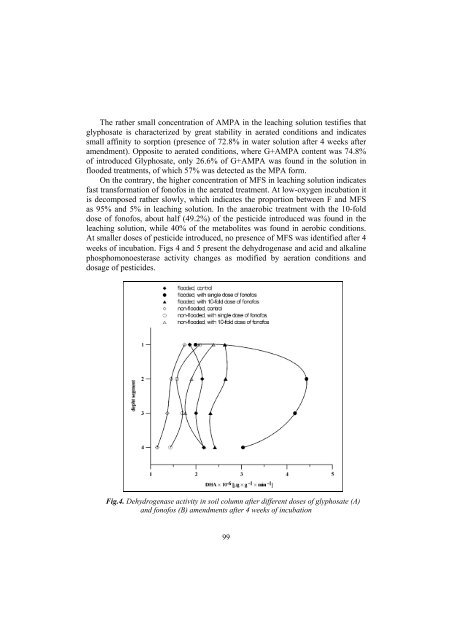soil - Lublin
soil - Lublin
soil - Lublin
You also want an ePaper? Increase the reach of your titles
YUMPU automatically turns print PDFs into web optimized ePapers that Google loves.
The rather small concentration of AMPA in the leaching solution testifies that<br />
glyphosate is characterized by great stability in aerated conditions and indicates<br />
small affinity to sorption (presence of 72.8% in water solution after 4 weeks after<br />
amendment). Opposite to aerated conditions, where G+AMPA content was 74.8%<br />
of introduced Glyphosate, only 26.6% of G+AMPA was found in the solution in<br />
flooded treatments, of which 57% was detected as the MPA form.<br />
On the contrary, the higher concentration of MFS in leaching solution indicates<br />
fast transformation of fonofos in the aerated treatment. At low-oxygen incubation it<br />
is decomposed rather slowly, which indicates the proportion between F and MFS<br />
as 95% and 5% in leaching solution. In the anaerobic treatment with the 10-fold<br />
dose of fonofos, about half (49.2%) of the pesticide introduced was found in the<br />
leaching solution, while 40% of the metabolites was found in aerobic conditions.<br />
At smaller doses of pesticide introduced, no presence of MFS was identified after 4<br />
weeks of incubation. Figs 4 and 5 present the dehydrogenase and acid and alkaline<br />
phosphomonoesterase activity changes as modified by aeration conditions and<br />
dosage of pesticides.<br />
Fig.4. Dehydrogenase activity in <strong>soil</strong> column after different doses of glyphosate (A)<br />
and fonofos (B) amendments after 4 weeks of incubation<br />
99

















